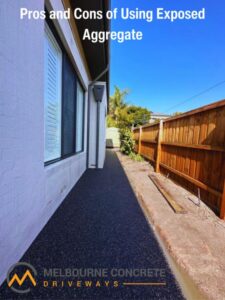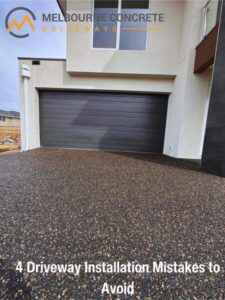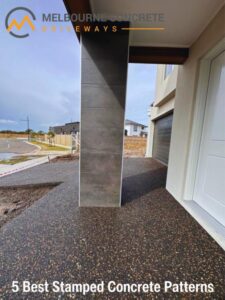Yes, coloured concrete is worth it because colored concrete is a cost effective way to add visual appeal and interest to otherwise plain concrete.
For those with a particularly large concrete patio or driveway, you may want to make its design more unique by adding some colour. There are many concreters in Melbourne who received constant requests to use coloured concrete for replicating textured paths or the natural environment.
In this post, we’ll discuss how coloured concrete is made, its advantages, and where you can use it on your property.
How Do You Get Coloured Concrete?
You get coloured concrete by adding mineral oxide pigments to the concrete mix during the batching process. These pigments, which come in powder or liquid form, are blended with the other materials before the concrete is poured. This ensures a uniform distribution of colour throughout the mix.
The choice of pigment depends on the desired shade, as different minerals produce different colours. Commonly used pigments include iron oxide for reds, chromium oxide for greens, and cobalt for blues. It’s crucial to use the correct dosage of pigment to maintain the strength and consistency of the concrete.
Builders often refer to a colour chart to select the appropriate pigment and ensure that the final product meets the expected aesthetic standards.
Want to know the difference between concrete and cement? Check out our blog for more details.
Advantages of Coloured Concrete
The following are the advantages of coloured concrete:
It Looks Aesthetically Pleasing
Coloured concrete offers a visual appeal that standard concrete cannot match. By integrating colours, it harmonises with other elements of the site, enhancing the overall appearance.
This versatility in design allows for customisation, enabling architects and builders to achieve a more refined and cohesive look.
It’s Quite Versatile
The adaptability of coloured concrete makes it suitable for various applications, from driveways and footpaths to indoor floors and architectural details. It can mimic other materials like brick, slate, or stone, providing a cost-effective alternative with similar visual effects.
It’s Environmentally Friendly
Using coloured concrete is beneficial for the environment. The pigments used are often derived from natural minerals, which are less harmful to the ecosystem compared to synthetic dyes.
Additionally, concrete’s longevity means less frequent replacement and lower material turnover, contributing to sustainability.
It Can Improve Property Value
Incorporating coloured concrete into a property’s design can significantly enhance its market value. Aesthetically appealing and durable surfaces are highly prized attributes that attract prospective buyers.
The unique and customised appearance of coloured concrete installations often leads to higher valuations due to their added visual appeal and longevity.

Where Can I Use Coloured Concrete?
You can use coloured concrete in places on your property that you want to stand out. Despite being more costly than stencilled concrete, coloured concrete is more versatile since it allows you to experiment.
For example, you can design multi-coloured concrete blocks and use those as walls. You can also create a pathway that uses vibrant colours leading to your garden.
Ultimately, coloured concrete is an ideal choice for use in various locations, no matter your design style or project in mind.






